这道题慢悠悠地做,出现了很多错误,大多都是空指针产生的中断,最后还是实现了,代码写得有点乱,有时间优化下(当然有同学指点下也是不错的,哈哈)。
实习题目:
设计一个按优先数调度算法实现处理器调度的程序。
[提示]:
(1) 假定系统有5个进程,每个进程用一个PCB来代表。PCB的格式为:
进程名、指针、要求运行时间、优先数、状态。
进程名——P1~P5。
指针——按优先数的大小把5个进程连成队列,用指针指出下一个进程PCB的首地址。
要求运行时间——假设进程需要运行的单位时间数。
优先数——赋予进程的优先数,调度时总是选取优先数大的进程先执行。
状态——假设两种状态,就绪,用R表示,和结束,用E表示。初始状态都为就绪状态。
(2) 每次运行之前,为每个进程任意确定它的“优先数”和“要求运行时间”。
(3) 处理器总是选队首进程运行。采用动态改变优先数的办法,进程每运行1次,优先数减1,要求运行时间减1。
(4) 进程运行一次后,若要求运行时间不等于0,则将它加入队列,否则,将状态改为“结束”,退出队列。
(5) 若就绪队列为空,结束,否则,重复(3)。
思路流程图:
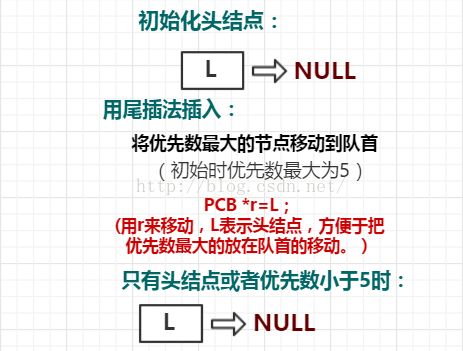
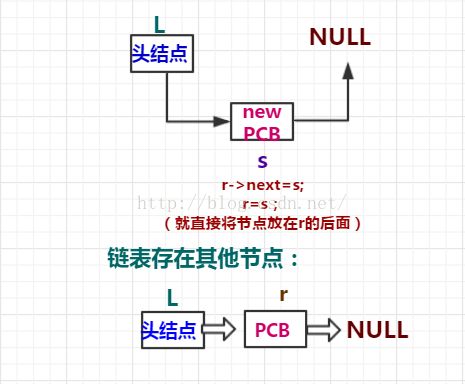
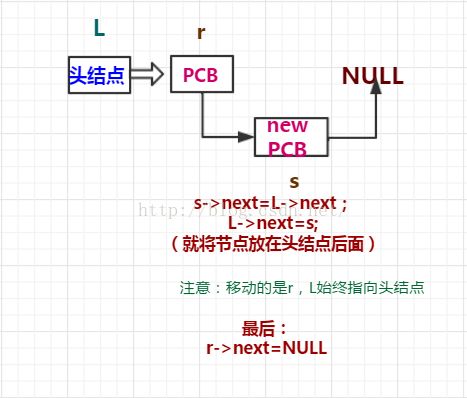

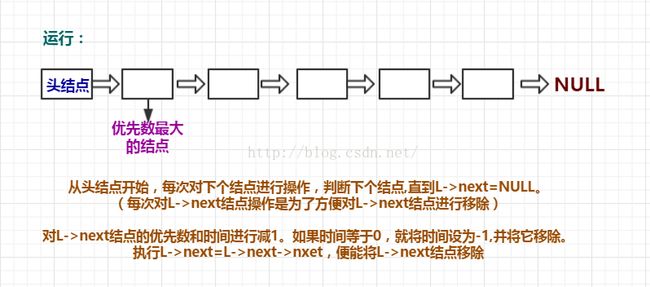
对运行时间的判断:
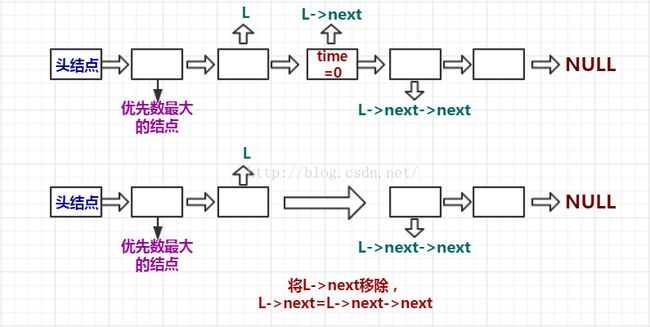
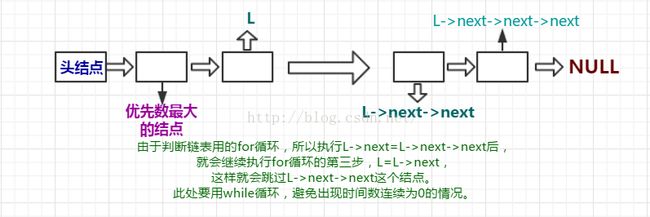
对优先数的判断:
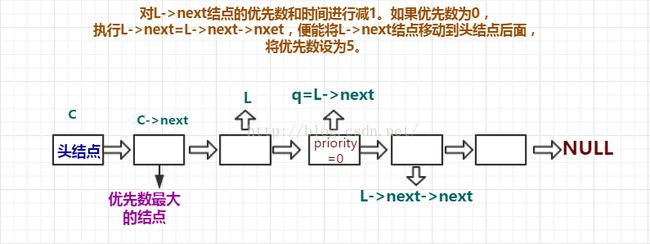
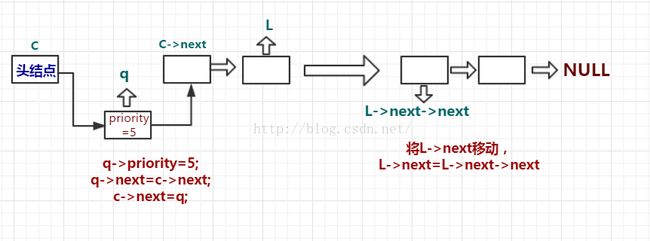

/*
author:huangpingyi
date:2016 11 24
*/
#include #include #include using namespace std;
static int point = 0;//用于计算进程是否运行完成
struct PCB
{
int pid;
int priority;
int time;
PCB *next;
};
void tailCreate(PCB *L)
{
srand((unsigned int)time(0));//以时间为随机数种子,保证每次随机数不一样
int priority = rand() % 5;//随机优先数
PCB *s, *r = L;
for (int i = 0; i<5; i++)
{
//随机时间为1到50
int number = rand() % 5;
while (number == 0)
//如果是0就一直随机,直到出现不是0的为止
number = rand() % 5;
//tail_insert用尾插法初始化
s = new PCB;
s->pid = i + 1;
s->priority = (i + priority) % 5 + 1;
s->time = number;
if (s->priority != 5 || r->next == NULL)//如果r->next==NULL表示为队列只有一个头结点,就直接插入
{
r->next = s;
r = s;
}
if ((s->priority == 5) && (r->next != NULL))//如果队列不为空,就将它放在头结点后面
{
s->next = L->next;
L->next = s;
}
}
r->next = NULL;
}
void run(PCB *L)//运行
{
PCB *c = L;
PCB *p = L;
for (L; L; L = L->next)
{
if (L->next == NULL)
break;
//由于存在存在头结点,所以从L->next开始
L->next->priority = L->next->priority - 1;
L->next->time = L->next->time - 1;
if (L->next->time == 0)
//如果运行时间为0,就将它移除队列中
{
cout << "run over" "<< L->next->pid << endl;
L->next->time = -1;
L->next = L->next->next;
//由于出现了L->next = L->next->next;这步,
//接着执行for循环的第三个表达式,便跳过了L->next->next这个结点,接着执行L->next->next->next这个结点
//所以需要判断一下L->next->next这个结点
if (L->next != NULL&&L->next->time != 0)
{
L->next->priority = L->next->priority - 1;
L->next->time = L->next->time - 1;
}
//如果L->next->next->time的值等于0,便会将它移除队列,接着执行L->next=L->next->next这步
//所以需要while循环来判断
while (L->next != NULL&&L->next->time == 0)
{
cout << "run over" "<< L->next->pid << endl;
L->next->time = -1;
L->next = L->next->next;
point = point + 1;
if (L->next != NULL)
{
L->next->priority = L->next->priority - 1;
L->next->time = L->next->time - 1;
}
}
point = point + 1;
}
if (L->next != NULL&&L->next->priority == 0)//如果优先数为0就将它变成0放在队首
{
//******
PCB *q = L->next;
L->next = L->next->next;
q->priority = 5;
q->next = c->next;
c->next = q;
//由于执行了L->next=L->next->next
//所以又会执行上面那步同样地操作
if (L->next != NULL&&L->next->time != 0)
{
L->next->priority = L->next->priority - 1;
L->next->time = L->next->time - 1;
}
while (L->next != NULL&&L->next->time == 0)
{
cout << "run over" << "->PID->"pid << endl;
L->next->time = -1;
L->next = L->next->next;
point = point + 1;
if (L->next != NULL)
{
L->next->priority = L->next->priority - 1;
L->next->time = L->next->time - 1;
}
}
}
}
L = p;
}
int main()
{
PCB *L, *m;
L = new PCB;//初始化头结点
L->next = NULL;
tailCreate(L);
m = L;
L = L->next;
cout << "=============" << endl;
cout << "Init" << endl;
cout << "==============" << endl;
for (L; L; L = L->next)
{
cout
cout << "Time :"
cout << "Priority :"
cout << "******* " << endl;
cout << endl;
}
cout << "=============" << endl;
cout << "Init successful!" << endl;
cout << "==============" << endl;
cout << endl;
cout << "run order!" << endl;
while (point != 5)
{
run(m);
}
system("pause");
return 0;
}
windows下:
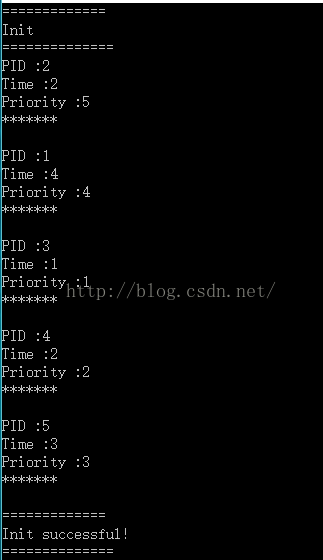
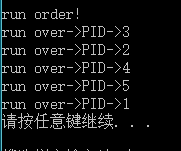
ubuntu:
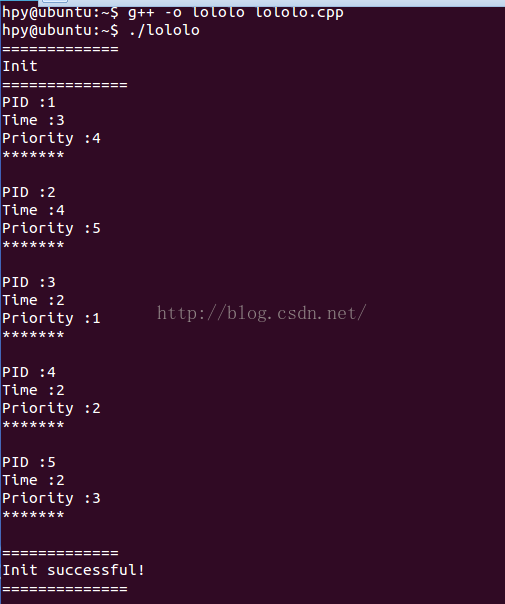

这里用了srand((unsigned int)time(0));函数以电脑时间为随机数种子,保证每次随机数不一样
这里设置的运行时间为1到5





















 1471
1471











 被折叠的 条评论
为什么被折叠?
被折叠的 条评论
为什么被折叠?








